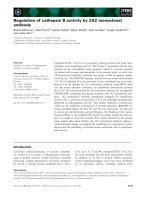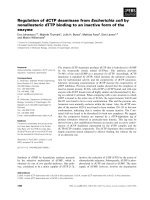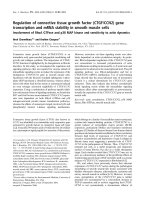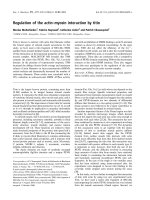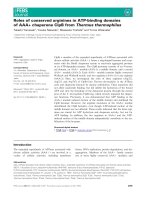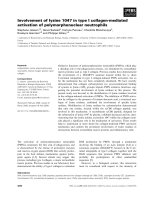báo cáo khoa học: " Regulation of hypoxia inducible factor-1a expression by the alteration of redox status in HepG2 cells" pdf
Bạn đang xem bản rút gọn của tài liệu. Xem và tải ngay bản đầy đủ của tài liệu tại đây (2.71 MB, 9 trang )
RESEARC H Open Access
Regulation of hypoxia inducible factor-1a
expression by the alteration of redox status in
HepG2 cells
Wen-sen Jin
1*
, Zhao-lu Kong
2
, Zhi-fen Shen
2
, Yi-zun Jin
2†
, Wu-kui Zhang
1
and Guang-fu Chen
1
Abstract
Hypoxia inducible factor-1 (HIF-1) has been considered as a critical transcriptional factor in response to hypoxia. It
can increase P-glycoprotein (P-Gp) thus generating the resistant effect to chemother apy. At present, the
mechanism regulating HIF-1a is still not fully clear in hypoxic tumor cells. Intracellular redox status is closely
correlated with hypoxic micro-environment, so we investigate whether alterations in the cellular redox status lead
to the changes of HIF-1a expression. HepG2 cells were exposed to Buthionine sulphoximine (BSO) for 12 h prior to
hypoxia treatment. The level of HIF-1a expression was measured by Western blot and immunocytochemistry
assays. Reduce glutath ione (GSH) concentrations in hypoxic cells were determined using glutathione reductase/5,5
’
-
dithiobis-(2-nitrob-enzoic acid) (DTNB) recycling assay. To further confi rm the effect of intracellular redox status on
HIF-1a expression, N-acetylcysteine (NAC) was added to culture cells for 8 h before the hypoxia treatment. The
levels of multidrug resistance gene-1 (MDR-1) and erythropoietin (EPO) mRNA targeted by HIF-1a in hypoxic cells
were further determined with RT-PCR, and then the expression of P-Gp protein was observed by Western blotting.
The results showed that BSO pretreatment down-regulated HIF-1a and the effect was concentration-dependent,
on the other hand, the increases of intracellular GSH contents by NAC could partly elevate the levels of HIF-1a
expression. The levels of P-Gp (MDR-1) and EPO were concomitant with the trend of HIF-1a expression. Therefore,
our data indicate that the changes of redox status in hypoxic cells may regulate HIF-1a expression and provide
valuable information on tumor chemotherapy.
Keywords: Hypoxia Redox, Multidrug resistance, HepG2
Introduction
The majority of transcriptional responses in cells to
hypoxia are mediated by hypoxia inducible factor-1(HIF-
1), a heterodimeric protein that consists of the steadily
expressed HIF-1b/ARNT and the highly regulated HIF-
1a subunits. The HIF-1 a subunit, under normoxic con-
ditions, is hydroxylated by prolyl hydroxylasamses
(PHDs) at praline residues 402 and 564 in the oxygen-
dependent degradation (ODD). Then it is targeted for
proteasome-mediated degradation through a protein ubi-
quitin ligase complex containing the product of the von
Hippel Lindau tumor suppressor (pVHL) [1,2]. Many
data revealed that there was a rapid biodegradation of
HIF-1a protein within 5-10 min when hypoxic condition
was changed into normoxic condition; furthermore the
expression of HIF-1a protein was undetectable by the
end of 30 min in normoxia [3,4]. In contrast, the degra-
dation pathway is blocked when cells are exposed to a
hypoxic environment, thereby allowing HIF-1a to accu-
mulate and migrate to the nucleus, where more than 100
genes have been identified as direct targets of HIF-1a
[5,6]. Among these genes, many are responsible for the
physiological or pathop hysiological activities of hypoxic
cells, including cell survival, glucose metabolism, glycoly-
sis and therapeutic resistance [7-9].
The expression level of HIF-1a is regulated by differ-
ent factors involving cell signal transduction pathway,
cytokines, heat-shock protein 90, reaction oxygen (ROS)
and nitric oxide (NO) [10-13]. It is well known that
* Correspondence:
† Contributed equally
1
Teaching & Research Section of Nuclear Medicine, An-hui Medical
University, Hefei, China
Full list of author information is available at the end of the article
Jin et al. Journal of Experimental & Clinical Cancer Research 2011, 30:61
/>© 2011 Jin et al; licensee BioMed Central Ltd. This is an Open Access article distr ibuted under the terms of the Creative Commons
Attribution License (http://creativecom mons.org/licenses/by/2.0), which permits unrestricted use, distribu tion, and reproduction in
any medium, provided the original wor k is properly cited.
intracellular antioxidant systems, such as reduce glu-
tathione (GSH), superoxide dismutase, glutathione per-
oxide, etc, can scavenge the excess ROS and sustain the
redox equilibrium in cells [14]. Studies have shown that
GSH play a role in protecting cells from oxide free radi-
cals, ROS and nitrogen radicals [15-17]. It is, therefore,
possible that the level of HIF-1a expression may be
regulated by modifying the redox status of hypoxic cells.
To test this hypothesis, we used redox reagents to
alter the con tents of intrac ellular GSH, which resulted
in the changes of redox status in hypoxic cells, then to
evaluate whether the modifications of redox status in
hypoxic cells can regulate HIF-1a protein levels.
Materials and methods
Cell viability assay (MTT)
The effect of BSO on tumor cell growth was determined
using an MTT colorimetric assay [18]. Cells were seeded
in 96-well plates at a density of 5 × 10
3
cells per well.
They were, then, treated with different concentrations of
BSO for 12 h. Furthermore, the medium was replaced
with fresh medium allowing cells to be continuously
grown up to 72 h. The 3-(4,5-dimethylthiazol-2-yl)-2,5-
diphenyltetrazo-lium bromide (MTT, Sigma) dye was
added to a final concentration of 50 mg/ml and cells
were subsequently incubated for another 4 h at 37°C.
The media containing residual MTT dye was carefully
aspirated from each of the wells and 200 μlDMSOwas
added to each well to dissolve the reduced formazan
dye. The effect of BSO on the growth of cells was deter-
mined from differences in absorbance. The fraction of
cells viability was calculated by comparing the optical
absorbance of culture given a BSO treatment with that
of the untreated control.
Cells culture and treatment
HepG2 cells (Cell Bank, Chinese A cademy of Sc iences)
were cultured in RPMI-1640 medium (GIBCO BAL,
USA) supplemented with 10% FBS, penicillin (100 U/
ml), streptomycin (100 μg/ml) at 37°C in an incubator
containing humid atmosphere of 95% air and 5%CO
2
and propagated according to protocol given by the
American Type Culture Collection. Hypoxic treatment
was in a controlled chamber maintained with 1% O
2
,
99%N
2
for 4 h. The medium was changed prior to
experiments. To investigate the effect of redox state on
the hypoxia induction of HIF-1a expression, the cells
were cultivated for 12 h in the absence or presence of
50 μM, 100 μMand200μM DL-Buthionine sulphoxi-
mine (BSO, Sigma, USA) before the 4-h hypoxia treat-
ment. In addition, 5 mM N-acetylcysteine (NAC)
(Sigma, USA), an antioxidant and GSH precursor, was
used to culture cells for 8 h before hypoxia to further
confirm the mechanism of BSO modulating the
expression of HIF-1a by the changes of micro-environ-
ment redox status in the cells.
Intracellular GSH assay
After the triplicate samples of 10
6
cells were treated
under different conditions, The GSH/GSSG ratios were
measured with the glutathione reductase/5,5
’
-dithiobis
-(2-nitro benzoic acid) (DTNB) recycling assay kit (Beyo-
time, China) under the methods recommended by the
manufacturer. The standard sample and checking sam-
ple cuvettes were placed into a dual-beam spectrophot-
ometer, and the increases in absorbance at 412 nm were
followed as a function of time. The standard curves of
total glutathione and GSSG concentrations were fitted
with absorbance, followed by determining the concen-
tration of checking samples. Concentrations were con-
verted to nmol/mg protein, and reduced GSH
concentrations were obtained by subtracting two times
GSSG from total glutathione. Finally, GSH/GSSG ratio,
with different treatment, was calculated through cellular
GSH concentration divided by GSSG concentration.
RNA purification
Cells were lysed by TRIzol Reagent and RNA was
extracted according to manufacturer’s instruction (San-
gon, China). To avoid genomic DNA contamination,
extracted RNA was then purified with the RNeasy kit
(Invitrogen, USA). The quantity and quality of RNA was
determined by the OD measurement at 260 and 280
nm. The integrity of RNA was checked by visual inspec-
tion of the two rRNAs 28S and 18S on an agarose gel.
RT-PCR
Two micrograms RNA was used for cDNA synthesis
using Olig-(dt)
18
as primer and AMV reverse t ranscrip-
tase. The RT reaction was started with 10 min incuba-
tion at room temperature, and then at 42°C for 60 min,
followed by 10 min at 70°C to terminate the reaction.
Subsequently, a 2 μl aliquot of cDNA was amplified by
PCR in a total volume of 25 μl containing 2.5 μl10×
PCR buffer (0.2 M Tris-HCl, pH 8.4, 0.5 M KCl), 0.2
mM dNTP mix, 1.5 mM MgCl
2
,0.2μM of each primer
and 1 .25 units of Platinum T aq DNA polymerase (Invi-
trogen, USA). The thermal cycler was set to run at 95°C
for 5 min, 30 cycles of 94°C for 30 s, 52°C for 30 s, 72°C
for 1 min, and a final extension of 72°C for 10 min. The
primers specific for multidrug resistance gene-1 (MDR-
1) and erythropoietin (EPO) (MDR-1 upstream: 5’-CCA
ATGATGCTGCTCAAGTT-3’ ; downstream: 5’-GTTC
AAACTTCTGCTCCT GA-3’; 297-bp fragment; EPO
upstream: 5’-ATATCACTGTCCCAGACACC-3’;down-
stream: 5’-AGTGATTGTTCGGAGT GGAG-3’ ;290-bp
fragme nt) were used, and for b -actin (upstream: 5’-GTT
GCGTTACACCCTTTCTTG-3’;downstream:5’-GACT
Jin et al. Journal of Experimental & Clinical Cancer Research 2011, 30:61
/>Page 2 of 9
GCTGT CACCTTCACCGT-3’; 157-bp fragment) were
as control . PCR products were analyzed by electrophor-
esis in 1.2% agarose gel. The specific bands were visua-
lized with ethidium bromide and digitally photographed
under ultraviolet light, furthermore scanned using Gel
Documentation System 920 (Nucleo Tech, San Mateo,
CA). Gene expression was calculated as the ratio of
mean band density of analyzed specific products to that
of the internal standard (b-actin).
Western blot analysis of HIF-1a expression
Cells were scraped off from culture flasks and lysed in
lysis buffer containing 10% glycerol, 10mMTris-HCL(PH
6.8), 1%SDS, 5 mM dithiothreitol (DTT) and 1× com-
plete protease inhibitor cocktail (Sigma, USA). The
method of Bradford was used to assay concentrations of
protein in diverse samples. Protein concentration was
measured using an auto multifunction microplate
reader. Fifty micrograms of cellular proteins were sepa-
rated by 8% polyacrylamide-SDS inc onsecutive gel elec-
trophoresis. The separated proteins were
electrophoretically transferred to polyvinylidene difluor-
ide membrane. Membranes were blocked with a 5%
skim milk in Tris-buffered saline (TBS) containing 0.1%
Tween 20 at room temperature for 1 h and then incu-
bated with mouse anti-human monoclonal HIF-1a
(Abcam, USA) at a 1:500 dilusion and P-glycoprotein
(P-Gp) antibody (Abcam, USA) at a 1:200 dilusion over-
night at 4°C, followed by goat anti-mouse IgG for 1 h at
room temperature. Signals were de tected with enhanc ed
chemiluminescence (ECL plus, Amersham, USA).
Microtubule protein (Tubulin, Abcam, USA) at a 1:1000
dilution was used as internal control to observe the
changes of HIF-1a and MDR-1 bands.
Immunocytochemistry analysis of HIF-1a expression
Cells grew on coverslips in 6-well culture dishes to
approach 70% confluence; they were then treated with
BSO and NAC as above description, following 4 h
hypoxic treatment. After the medium was completely
removed by suction, the cells were rinsed briefly with
phosphate buffer saline (PBS). T hen, 4% Formaldehyde
was used to fix the cells on coverslips for 10 min at
room temperature, and then methanol fixed the cells for
10 min at -20°C. To utilize 0.5% TritonX-100 enhanced
permeabilizations of the cells for 10 m in at room tem-
perature. The coverclips were pre-incubated with 3%
hydrogen peroxide (H
2
O
2
)-methyl alcohol mix so lution
for 10 min to block endogenous peroxidase activity, fol-
lowed by incubation for 30 min with block solution at
room temperature. Cells were incubated with primary
antibody, a mouse anti-human monoclonal HIF-1a anti-
body, at a 1:1300 dilution overnight at 4°C. Then cells
were incubated with biotinylated secondary antibody,
followed by a r outine immunoperoxidase processing.
After washed twice with PBS , these coverslips were
developed using diaminob enzidine (DAB) as a chromo-
gen, rinsed, gradient dehydrated by alcohol, and then
mounted on slides. The coverslips without primary anti-
body treatment was regarded as the negative control. H-
score values were used as a semi-quantitative evaluatio n
for immunocytochemistry [19].
Statistical analysis
Data were reported as the means ± SEM of three sepa-
rate experiments. Statistical significance was measured
by independent sample t test and analysis of variance. A
value of p < 0.05 was considered as statistically
significant.
Results
Selection of sublethal concentration of BSO
In order to select the appropriate concentration of BSO
for the study, a 12 h dose-response study was conducted
by exposing cells to different concentrations of BSO.
Cell viability was measured by the MTT assay. The
results showed that there was not significant decrease in
viability over a 12 h exposure to BSO concentration ran-
ging from 12.5 to 200 μM (Figure 1). In subsequent stu-
dies, the concentrations of BSO used were set at 50,
100, 200 μM.
Variations of intracellular redox status
As shown in Figure 2, BSO treatment led to significant
reduction of intracellular GSH level and the effect was
in a concentration-dependent man ner. Intracellular
GSSG contents were increased concomitant with BSO
concentrations, resulting to subsequent reductions of
GSH/GSSG ratios. The declines of GSH level were par-
tially restored from hypoxic cells by the addition o f 5
mM NAC prior to hypoxia. Co mpared with the cells in
the absence of NAC, there was an increase in GSH/
GSSG ratio in the presence of 5 mM NAC. It indicated
that BSO inhibited the accumulation of GSH in cells,
but t he effect could be partially reversed by NAC
treatment.
Effect redox status on HIF-1a expression
HIF-1a protein levels were measured using Western
blot after BSO pretreatment. When BSO concentration
reachedat50μM, the down-regulation of HIF-1a
expression, under the hypoxia condition, was observed
in HepG2 cell s. It is then very clear that HIF-1a pro-
teins in hypoxic ce lls were significantly decreased with
BSO concentrations gradually incr easing. In addition,
the inhibition of H IF-1a expression was reversed by 5
mM NAC supplement. However, we also found that
NAC failed to elevate the level of HIF-1a expression
Jin et al. Journal of Experimental & Clinical Cancer Research 2011, 30:61
/>Page 3 of 9
inhibited by BSO concentration at 200 μM. These
results were shown in Figure 3
To further verify the effect of redox status on HIF-1a
levels, we detected the expressions of HIF-1a proteins
by using immunocytochemistry technique (ICC). As
shown in Figure 4, cells showed more negative staining
than control group after BSO pretreatment and NAC
decreased the inhibition. The results were basically con-
sistent with Western blot result.
Changes of genes targeted by HIF-1
The levels of MDR-1 and EPO transcription were
detected through semi-quantitative RT-PCR. The results
displayed that the levels of MDR-1 and EPO mRNA
were declined in hypoxic cells when BSO concentration
was at 50 μM,butitwasn’t shown that there was a sta-
tistical significance at the MDR-1 and EPO mRNA of 50
μM BSO pretreatment compared with those of the
hypoxic control. Concomitant with the increases of BSO
concentrations, the level s of MDR-1 and EPO mRNA in
hypoxic cells were gradually decreased. And then the
inhibitory effects on MDR-1 and EPO mRNA, BSO con-
centrations reaching at 100 μMand200μM respec-
tively, were shown statistical differences. Meanwhile,
NAC could reduce the inhibition of BSO to MDR-1 and
EPO mRNA. Furthermore, the expression of P-gp by
MDR-1 translation, tested with western blotting, was
also confirmed with the change of MDR-1 mRNA.
Above experimental results were displayed in Figure 5
andFigure6.Itisthereforeclearthatredoxmicro-
environment may influence the levels of target genes
located at the downstream of HIF-1.
Discussion
Among intracellular antioxidative factors, GSH is the
tripeptide thiol L- g-glutamyl-L-cysteinyl-glycine, a ubi-
quitous endogenous antioxidant. It plays an important
role in maintaining intracellular redox equilibrium and
in augmenting cellular defenses in oxidative stress
[20,21]. In above antioxidant response, GSH is con-
verted into gluta thione oxidized disulfide (GSSG), which
is recycled back to 2GSH by GSSG reductase, then
forming w hat is known as a redox cycle. Under normal
condition, the majority of glutathione is in the reduced
form. Shifting redox equilibrium is in favor of a redu-
cing or oxidizing state; that is in modification of the
redox status in cells [22,23]. The g-glutamylcysteine
sythetase (g-GCS) is the key rate-limiting enzyme
Figure 1 Toxicity of BSO on HepG2 cells. Under normoxic or hypoxic condition, HepG2 cells were treated with different concentration of BSO
for 12 h before subjected to the MTT assay. The viability was calculated by subtracting the background absorbance and divided by the control
absorbance. Both normoxia and hypoxia, the results showed that there was not significance in the decrease of cells viability until the
concentration of BSO was at 400 μM. The change of cells viability, under normoxia or hypoxia, was displayed in Diagram A and Diagram B
respectively.
Jin et al. Journal of Experimental & Clinical Cancer Research 2011, 30:61
/>Page 4 of 9
synthesizing intracellular GSH, so intracellular GSH
contents can be decreased by the inhibition of g-GCS
[24,25]. In t he present study, our results showed that
BSO, an inhibitor of g-GCS, down-regulated the expres-
sion of GSH un der hypoxia condition and the inhib itory
effect was conce ntration-dependent. Conversely, intra-
cellular GSH contents could be increased by adding
NAC to medium. It is therefore apparent that the ratios
of GSH and GSSG revealed the alterations of redox sta-
tus in hypoxic cells by redox r eagents pretreatment.
Interestin gly, we also noted that, as a precursor of GSH
biosynthesis, NAC could not significantly decrease the
suppression of GSH contents in the cells by 200 μm
BSO pretreatment. One possibility was that , as high-
concentration of BSO irreversibly suppresses the most
parts of g-GCS activities [24], the synthesis of GSH had
been saturated without conspicuous increased by the
addition of enzyme substrate.
Our following research showed that the down- reg ula-
tion of HIF-1a in hypoxic cells by different concentra-
tions BSO pretreatment, on the contrary, NAC could
partly decrease the inhibitory effect. Similar to our
results, the previous studies also showed that NAC,
under chemical and physiolo gical hypoxia, increased the
expression of HIF-1a by changing cytoplasmic micro-
environment redox state [26-28]. So it was clear that the
redox status in hypoxic cells could influence the expres-
sion of HIF-1a protein. Combining the previous
researches with our results, we considered the mechan-
ism, the redox status influencing the expression of HIF-
1a, as following: (i) The biosynthesis of GSH impose a
reducing micro-environment, subsequently prolonging
thehalf-lifeofHIF-1a and protracting its stability in
cytosol and favouring its translocation [28]; (ii) GSH
anti-oxidant system can effectively clear away free radi-
cals and ROS that may suppress the expression of HIF-
1a according to many previous studies [29,30]. How-
ever, it should be noted that some recent reports
showed the opposite results, GSH contents being nega-
tive correlation with the levels of HIF-1a [31,32] . Based
on other data, there could be the following factors con-
tributing to these controversial p henomena: (i) Various
cell types and experimental methods were used in differ-
ent studies; (ii) The varies of GSH/GSSG equilibrium in
different cells could exist in a certain range [23]. Exces-
sive reducing status led to the extreme scavenging of
the most of ROS and free radicals in hypoxic cells, but a
bit of ROS generation from mitochondria possibly
induced the expression of HIF-1a [33].
To further judge our finding, the expressions of MDR-
1 and EPO, the down-stream target genes by HIF-1 pro-
moting transcription in hypoxic cells, were observed in
Figure 2 The changes of redox status in hypoxic cells by different pretreatment. (A) showed the alteration of intracellular GSH and GSSG
contents in HepG2 cells under hypoxic condition; (B) showed the ratios of GSH and GSSG in HepG2 cells under hypoxic condition. (
◆
p < 0.05,
#
p
< 0.01, as compared with hypoxia control;
▲
p < 0.05, *p < 0.01, as compared with the cells by NAC treatment).
Jin et al. Journal of Experimental & Clinical Cancer Research 2011, 30:61
/>Page 5 of 9
Figure 3 The change of HIF-1a proteins in HepG2 cells under hypoxic condition by Western blotting measurement. (A) The representative
gel picture was taken from three separate experiments. (B) Compared with hypoxic control, the expression of HIF-1a was reduced in BSO
concentration-dependent manner, and the analysis of relative densities showed that there was statistical difference the experimental cells by 100
and 200 μM BSO pretreatment respectively (
◆
p < 0.05,
#
p < 0.01). After NAC incubation, the expression of HIF-1a was elevated again, and there
were significant difference between the group with 100 μM NAC treatment and that without NAC treatment (
▲
P < 0.01).
Figure 4 ThechangeofHIF-1a expression by ICC assay. (A) The picture of ICC was shown. a: negative control; b: normoxic control; c:
hypoxic control; d: the hypoxic cells by 50 μM BSO pretreatment; e: the hypoxic cells by 100 μM BSO pretreatment; f: the hypoxic cells by 200
μM BSO pretreatment; g: the hypoxic cells by 50 μM BSO + 5 mM NAC pretreatment; j: the hypoxic cells by 100 μM BSO + 5 mM NAC
pretreatment; k: the hypoxic cells by 200 μM BSO + 5 mM NAC pretreatment. (B) The results of statistical analysis were shown with H-score
values of semi-quantitative evaluations. (
◆
P <0.05,
#
p < 0.01, compared with hypoxic control; *P <0.05, compared with the hypoxic cells by 5 mM
NAC pretreatment).
Jin et al. Journal of Experimental & Clinical Cancer Research 2011, 30:61
/>Page 6 of 9
the present study. MDR-1 could encode P-gp at the
membrane, effluxing chemtherapeutic reagents, to the
resistance of tumor therapy. Under hypoxic c ondition,
HIF-1 triggers t he expressions o f MDR-1 and EPO by
binding to hypoxia-responsive elements (HRE) at posi-
tions -49 to -45 within the function regions of genes
[34]. We found that the changing trend of MDR-1 and
EPO was also coincident with the expression of HIF-1a.
Consistent in ou r results, so me previous studies using
hypoxic DU-145 cells showed that intracellular redox
status gave rise to the obvious alterations of MDR-1
expression [35,36]. Meanwhile, other study revealed
Figure 5 The changes of MDR-1 expressions by RT-PCR and Western blotting measurement. Letter N means the cells under normoxic
condition; Letter H means the cells under hypoxic condition: (A) The representative gel picture was taken from three separate RT-PCR
experiments. (B) Compared with hypoxic control, the analysis of relative densities showed that there was statistical difference the experimental
cells by 100 and 200 μM BSO pretreatment respectively (
#
p < 0.01). After NAC incubation, the expression of MDR-1 was elevated again, and
there were significant difference between the group with 100 μM NAC treatment and that without NAC treatment (
▲
P < 0.05). (C) The
representative gel picture was taken from three separate Western blotting experiments. (D) Compared with hypoxic control, the analysis of
relative densities showed that there was statistical difference the experimental cells by 100 and 200 μM BSO pretreatment respectively (
#
p <
0.01). After NAC incubation, the expression of MDR-1 was elevated again, and there were significant difference between the group with 100 μM
NAC treatment and that without NAC treatment (
◆
P < 0.01).
Jin et al. Journal of Experimental & Clinical Cancer Research 2011, 30:61
/>Page 7 of 9
that, under hypoxic condit ion, the concentration of EPO
in plasma was e nhanced by oral NAC treatment, the
shifting of EPO could be further associated with an
increased expression of HIF-1 [37]. Thus above fi nding s
also have another implication that regulating micro-
environment redox status in hypoxic tumor cells may be
beneficial to tumor chemotherapy by reduction of the
expression of MDR-1 dependent upon HIF-1a.
Taken togethe r, our results suggest that the alteration
of intracellular micro-environment redox state can regu-
late the level of HIF-1a expression in hypoxic HepG2
cells. It is well known that the cellular and tissue’ s
response to hypoxia is a centr al process in the pa tho-
physiology of several diseases, including cancer, cardio-
vascular and respiratory disease, and so on [5,38,39].
The expression of HIF-1 plays an important role in
above pathophysiological processes. It is valua ble that
the design o f new type drugs is utilized to aim at the
expression of HIF-1a through researching the mechan-
ism of its expression in detail.
Abbreviations
HIF-1: Hypoxia inducible factor; BSO: Buthionine sulphoximine; GSH:
Reduce glutathione; NAC: N-acetylcysteine; EPO: erythropoietin.
Acknowledgements
We thank Mr. Shun-gao Tong and Mr. Hua-jun Ji (Institute of Radiation
Medicine, Fudan University, Shanghai City) for constant supports, and Dr.
Sheng-quan Zhang (College of Basic Medicine, An-hui Medical University,
Hefei City) for technical help. This study was financially supported by
National High-tech R&D Program, China, grant 2002AA2Z3104, National
Natural Science Foundation of China, grant 30500 143 and Scientific
Research Foundation of An-hui Medical University, grant 010503101.
Author details
1
Teaching & Research Section of Nuclear Medicine, An-hui Medical
University, Hefei, China.
2
Eighth Laboratory, Institute of Radiation Medicine,
Fudan University, Shanghai, China.
Authors’ contributions
WSJ, YZJ: Conceived and designed the experiments;
ZLK, ZFS: Performed the experiments and analysed the data;
WKZ, GFC: Contributed reagents/material/analysis tools/.
All authors read an approved the final draft.
Competing interests
The authors declare that they have no competing interests.
Received: 5 March 2011 Accepted: 19 May 2011 Published: 19 May 2011
References
1. Bruick RK, Mcknight SL: A conserved family of prolyl-4-hydroxylases that
modify HIF. Science 2001, 294:1337-1340.
2. Conaway RC, Brower CS Conaway JW: Emerging roles of ubiquitin in
transcriptional regulation. Science 2002, 296:1254-1258.
3. Salceda S, Caro J: Hypoxia-inducible factor 1alpha (HIF-1alpha) protein is
rapidly degraded by the ubiquitin-proteasome system under normoxic
Figure 6 The changes of EPO expressions by RT-PCR measurement. Letter N means the cells under normoxic condition; Letter H means the
cells under hypoxic condition: (A) The representative gel picture was taken from three separate RT-PCR experiments. (B) Compared with hypoxic
control, the analysis of relative densities showed that there was statistical difference the experimental cells by 100 and 200 μM BSO pretreatment
respectively (
#
p < 0.01). After NAC incubation, the expression of EPO was elevated again, and there were significant difference between the
group with 100 μM NAC treatment and that without NAC treatment (
▲
P < 0.01).
Jin et al. Journal of Experimental & Clinical Cancer Research 2011, 30:61
/>Page 8 of 9
conditions. Its stabilization by hypoxia depends on redox-induced
changes. J Biol Chem 1997, 272:22642-22647.
4. Cockman ME, Masson N, Mole DR, Jaakkola P, Chang GW, Clifford SC,
Maher ER, Pugh CW, Ratcliffe PJ, Maxwell PH: Hypoxia inducible factor-
alpha binding and ubiquitylation by the von Hippel-Lindau tumor
suppressor protein. J Biol Chem 2000, 275:25733-25741.
5. Semenza GL: Targeting HIF-1 for cancer therapy. Nat Rev Cancer 2003,
3:721-732.
6. Rademakers SE, Span PN, Kaanders JH, Sweep FC, van der Kogel AJ,
Bussink J: Molecular aspects of tumour hypoxia. Mol Oncol 2008, 2:41-53.
7. Sasabe E, Zhou X, Li D, Oku N, Yamamoto T, Osaki T: The involvement of
hypoxia-inducible factor-1alpha in the susceptibility to gamma-rays and
chemotherapeutic drugs of oral squamous cell carcinoma cells. Int J
Cancer 2007, 120:268-277.
8. Jantsch J, Chakravortty D, Turza N, Prechtel AT, Buchholz B, Gerlach RG,
Volke M, Gläsner J, Warnecke C, Wiesener MS, Eckardt KU, Steinkasserer A,
Hensel M, Willam C: Hypoxia and hypoxia-inducible factor-1 alpha
modulate lipopolysaccharide-induced dendritic cell activation and
function. J Immunol 2008, 180:4697-4705.
9. Lidgren A, Bergh A, Grankvist K, Rasmuson T, Ljungberg B: Glucose
transporter-1 expression in renal cell carcinoma and its correlation with
hypoxia inducible factor-1 alpha. BJU Int 2008, 101:480-484.
10. Zhou J, Brune B: Cytokines and hormones in the regulation of hypoxia
inducible factor-1alpha (HIF-1alpha). Cardiovasc Hematol Agents Med Chem
2006, 4:189-197.
11. Koga F, Kihara K, Neckers L: Inhibition of cancer invasion and metastasis
by targeting the molecular chaperone heat-shock protein 90. Anticancer
Res 2009, 29:797-807.
12. Triantafyllou A, Liakos P, Tsakalof A, Georgatsou E, Simos G, Bonanou S:
Cobalt induces hypoxia-inducible factor-1alpha (HIF-1alpha) in HeLa
cells by an iron-independent, but ROS-, PI-3K- and MAPK-dependent
mechanism. Free Radic Res 2006, 40:847-856.
13. Callapina M, Zhou J, Schmid T, Köhl R, Brüne B: NO restores HIF-1alpha
hydroxylation during hypoxia: role of reactive oxygen species. Free Radic
Biol Med 2005, 39:925-936.
14. Chen H, Chow PH, Cheng SK, Cheung AL, Cheng LY, O WS: Male genital
tract antioxidant enzymes: their source, function in the female, and
ability to preserve sperm DNA integrity in the golden hamster. J Androl
2003, 24:704-711.
15. Zhang J: Suppression of phosphoenolpyruvate carboxykinase gene
expression by reduced endogenous glutathione level. Biochim Biophys
Acta 2007, 1772:1175-1181.
16. Lu Y, Cederbaum A:
The mode of cisplatin-induced cell death in CYP2E1-
overexpressing HepG2 cells: modulation by ERK, ROS, glutathione, and
thioredoxin. Free Radic Biol Med 2007, 43:1061-1075.
17. Grosicka-Maciag E, Kurpios D, Czeczot H, Szumiło M, Skrzycki M, Suchocki P,
Rahden-Staroń I: Changes in antioxidant defense systems induced by
thiram in V79 Chinese hamster fibroblasts. Toxicol In Vitro 2008, 22:28-35.
18. Bildirici I, Bukulmez O, Ensari A, Yarali H, Gurgan T: A prospective
evaluation of the effect of salpingectomy on endometrial receptivity in
cases of women with communicating hydrosalpinges. Hum Reprod 2001,
16:2422-2426.
19. Lin T, Yang MS: Benzo[a]pyrene-induced elevation of GSH level protects
against oxidative stress and enhances xenobiotic detoxification in
human HepG2 cells. Toxicology 2007, 235:1-10.
20. Griffith OW, Mulcahy RT: The enzymes of glutathione synthesis: gamma-
glutamylcysteine synthetase. Adv Enzymol Relat Areas Mol Biol 1999,
73:209-267.
21. Haddad JJ, Harb HL: L-gamma-Glutamyl-L-cysteinyl-glycine (glutathione;
GSH) and GSH-related enzymes in the regulation of pro-and anti-
inflammatory cytokines: a signaling transcriptional scenario for redox(y)
immunologic sensor(s)? Mol Immunol 2005, 42:987-1014.
22. Haddad JJ: Antioxidant and prooxidant mechanisms in the regulation of
redox(y)-sensitive transcription factors. Cell Signal 2002, 14:879-897.
23. Haddad JJ: Oxygen homeostasis, thiol equilibrium and redox regulation
of signalling transcription factors in the alveolar epithelium. Cell Signal
2002, 14:799-810.
24. Bełtowski J, Jamroz-Wiśniewska A, Wójcicka G, Lowicka E, Wojtak A: Renal
antioxidant enzymes and glutathione redox status in leptin-induced
hypertension. Mol Cell Biochem 2008, 319:163-174.
25. Akai S, Hosomi H, Minami K, Tsuneyama K, Katoh M, Nakajima M, Katoh M,
Nakajima M, Yokoi T: Knock down of gamma-glutamylcysteine synthetase
in rat causes acetaminophen-induced hepatotoxicity. J Biol Chem 2007,
282:23996-24003.
26. Sommani P, Yamashita K, Miyoshi T, Tsunemine H, Kodaki T, Mori H,
Hirota K, Arai T, Sasada M, Makino K: Inhibitory effect of 6-formylpterin on
HIF-1alpha protein accumulation. Biol Pharm Bull 2007, 30:2181-2184.
27. Nikinmaa M, Pursiheimo S, Soitamo AJ: Redox state regulates HIF-1alpha
and its DNA binding and phosphorylation in salmonid cells. J Cell Sci
2004, 117:3201-3206.
28. Haddad JJ, Olver RE, Land SC: Antioxidant/pro-oxidant equilibrium
regulates HIF-1alpha and NF-kappa B redox sensitivity. Evidence for
inhibition by glutathione oxidation in alveolar epithelial cells.
J Biol Chem
2000, 275:21130-21139.
29. Wellman TL, Jenkins J, Penar PL, Tranmer B, Zahr R, Lounsbury KM: Nitric
oxide and reactive oxygen species exert opposing effects on the
stability of hypoxia-inducible factor-1alpha (HIF-1alpha) in explants of
human pial arteries. FASEB J 2004, 18:379-381.
30. Liu Q, Berchner-Pfannschmidt U, Möller U, Brecht M, Wotzlaw C, Acker H,
Jungermann K, Kietzmann T: A Fenton reaction at the endoplasmic
reticulum is involved in the redox control of hypoxia-inducible gene
expression. Proc Natl Acad Sci USA 2004, 101:4302-4307.
31. Khromova NV, Kopnin PB, Stepanova EV, Agapova LS, Kopnin BP: p53 hot-
spot mutants increase tumor vascularization via ROS-mediated
activation of the HIF1/VEGF-A pathway. Cancer Lett 2009, 276:143-151.
32. Wu YL, Piao DM, Han XH, Nan JX: Protective effects of salidroside against
acetaminophen-induced toxicity in mice. Biol Pharm Bull 2008,
31:1523-1529.
33. Chandel NS, Maltepe E, Goldwasser E, Mathieu CE, Simon MC,
Schumacker PT: Mitochondrial reactive oxygen species trigger hypoxia-
induced transcription. Proc Natl Acad Sci USA 1998, 95:11715-11720.
34. Comerford KM, Wallace TJ, Karhausen J, Louis NA, Montalto MC, Colgan SP:
Hypoxia-inducible factor-1-dependent regulation of the multidrug
resistance (MDR1) gene. Cancer Res 2002, 62:3387-3394.
35. Huang XZ, Wang J, Huang C, Chen YY, Shi GY, Hu QS, Yi J: Emodin
enhances cytotoxicity of chemotherapeutic drugs in prostate cancer
cells: the mechanisms involve ROS-mediated suppression of multidrug
resistance and hypoxia inducible factor-1. Cancer Biol Ther 2008,
7:468-475.
36. Wartenberg M, Ling FC, Müschen M, Klein F, Acker H, Gassmann M,
Petrat K, Pütz V, Hescheler J, Sauer H: Regulation of the multidrug
resistance transporter P-glycoprotein in multicellular tumor spheroids by
hypoxia-inducible factor (HIF-1) and reactive oxygen species. FASEB J
2003, 17:503-525.
37. Hildebrandt W, Alexander S, Bärtsch P, Dröge W: Effect of N-acetyl-
cysteine on the hypoxic ventilatory response and erythropoietin
production: linkage between plasma thiol redox state and O(2)
chemosensitivity. Blood 2002, 99:1552-1555.
38. Vinhaes EN, Dolhnikoff M, Saldiva PH: Morphological changes of carotid
bodies in acute respiratory distress syndrome: a morphometric study in
humans. Braz J Med Biol Res 2002, 35:1119-1125.
39. Garvey JF, Taylor CT, McNicholas WT: Cardiovascular disease in obstructive
sleep apnoea syndrome: the role of intermittent hypoxia and
inflammation. Eur Respir J 2009, 33:1195-1205.
doi:10.1186/1756-9966-30-61
Cite this article as: Jin et al.: Regulation of hypoxia inducible factor-1a
expression by the alteration of redox status in HepG2 cells. Journal of
Experimental & Clinical Cancer Research 2011 30:61.
Jin et al. Journal of Experimental & Clinical Cancer Research 2011, 30:61
/>Page 9 of 9



